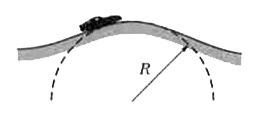In fig a stuntman drives a car (without negative lift) over the top of a hill, the cross section of a hill, the cross section of which can be approximated by a circle of radius R=250 m. What is the greatest speed at which he can drive without the car leaving the road at the top of the hill?

The correct Answer is:50 m/s
Step by step video, text & image solution for In fig a stuntman drives a car (without negative lift) over the top of a hill, the cross section of a hill, the cross section of which can be approximated by a circle of radius R=250 m. What is the greatest speed at which he can drive without the car leaving the road at the top of the hill? by Physics experts to help you in doubts & scoring excellent marks in Class 12 exams.
Topper's Solved these Questions
- BOOK - RESNICK AND HALLIDAYCHAPTER - CIRCULAR MOTIONEXERCISE - PRACTICE QUESTIONS(SINGLE CORRECT CHOICE TYPE)40videos
CIRCULAR MOTION
- BOOK - RESNICK AND HALLIDAYCHAPTER - CIRCULAR MOTIONEXERCISE - PRACTICE QUESTIONS(MORE THAN ONE CORRECT CHOICE TYPE)6videos
CIRCULAR MOTION
- BOOK - RESNICK AND HALLIDAYCHAPTER - CIRCULAR MOTIONEXERCISE - CHECK POINTS6videos
CIRCULAR MOTION
- BOOK - RESNICK AND HALLIDAYCHAPTER - CIRCUITSEXERCISE - Practice Questions (Integer Type)3videos
CIRCUITS
- BOOK - RESNICK AND HALLIDAYCHAPTER - CURRENT AND RESISTANCEEXERCISE - Practice Questions (Integer Type)3videos
CURRENT AND RESISTANCE
Similar Questions
The roadway bridge over a cannot is in the form of an arc of a circle of radius 20 m. what is the maximum speed with which a car cann cross the bridge without leaving the ground at the highet point ?
View SolutionA car moves at a constant speed on a straigh but hilly road. One section has a crest and dip of the 250m radius.
(a) As the car passes over the crest the normal force on the car is half the 16kN weight of the car. What will the noraml force on the car its passes through th ebottom of the dip?
(b) What is the greatest speed at which the car can move without leaving the road at the top of the hill ?
(c) Moving at a speed found in part (b) what will be the normal force on the car as it moves through the bottom of the dip? (Take, g=10m/s2)View Solution
Knowledge Check
- Question 1 - Select One
The roadway of a bridge over a canal is in the form of a circular arc of radius 18 m. What is the greatest speed with which a motor cycle can cross the bridge without leaving ground.
A√98 m/sB√18×9.8 m/sC18×9.8 m/sD18/9.8 m/s - Question 2 - Select One
A national roadway bridge over a canal is in the form of an arc of a circle of radius 49 m. What is the maximum speed with which a car can move without leaving the ground at the highest point? (Take,g=9.8ms−2)
A19.6ms−1B40ms−1C22ms−1DNone of the above - Question 3 - Select One
In the section of a bridge on a river is an arc of a circle of radius 88.2m, then the maximum speed with which a car can travel over the bridge without losing contact with the ground level will be
A29.4m/sB9m/sC81m/sD18m/s
A roadway bridge over a rivulet is in the form of quarter of a circle of radius 60 m. What is the maximum speed with which a car can pass over the bridge without leaving the ground at any point ?
View SolutionThe roadway bridge over a canal is the form of an arc of a circle of radius 20 m. What is the minimum speed with which a car can cross the bridge without leaving contact with the ground at the highest point (g = 9.8 m/s2
View SolutionThe railway bridge over a canal is in the form of an arc of a circle of radius 20m. What is the minimum speed with which a car can cross the bridge without leaving contact with the ground at the highest point ? Take g=9.8ms−2
View SolutionThe railway bridge over a canal is in the from of an arc of a circle of radius 20m What is the minimum speed with which a car can cross the bridge without eving contact with the ground at the highest point Take g=9.8ms−2 .
View SolutionA bridge is in the form of a semicircle of radius 40m. The greatest speed with which a motorcycle can cross the bridge without leaving the ground at the highest point (frictional force is negligibly small)
View Solution

